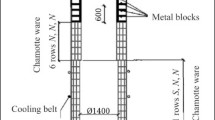Abstract
The workers of the Azovsta’ integrated iron-and-steel works have determined the causes of early wear of main roofs of open-hearth furnaces. They have resorted to lining the main roofs by periclase-chromite refractories of grade LIIIV produced in Slovakia. The use of refractories of grade LIIIV has increased the endurance of the main roofs of open-hearth furnaces by 100 heats. A petrographic study has shown that the high operating properties of articles made of LIIIV are due to their composition and structure, obtained as a result of the use of high-quality initial materials (chromite ore and magnesite powder) and a modern manufacturing process. Introduction of the developed manufacturing process has increased substantially the endurance of the linings and reduced the number of cold repairs of the open-hearth furnaces and the consumption of refractories.
Similar content being viewed by others
References
D. I. Gavrish,Refractory Industry [in Russian], Vol. 2, Metallurgiya, Moscow (1965).
I. S. Kainarskii and É. V. Degtyareva,Basic Refractories [in Russian], Metallurgiya, Moscow (1974).
Author information
Authors and Affiliations
Additional information
Translated from Ogneupory i Tekhnicheskaya Keramika, No. 6, pp. 34–38, June, 1997.
Rights and permissions
About this article
Cite this article
Nagornyi, A.P., Travinchev, A.I., Kravchenko, A.I. et al. Experience in using periclase-chromite refractories in roofs of tilting open-hearth furnaces. Refract Ind Ceram 38, 244–247 (1997). https://doi.org/10.1007/BF02768260
Received:
Issue Date:
DOI: https://doi.org/10.1007/BF02768260




